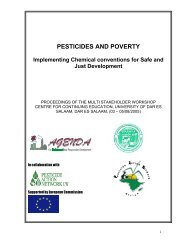Your Daily Poison - Pesticide Action Network UK
Your Daily Poison - Pesticide Action Network UK
Your Daily Poison - Pesticide Action Network UK
Create successful ePaper yourself
Turn your PDF publications into a flip-book with our unique Google optimized e-Paper software.
1 <strong>Pesticide</strong> exposure in the environment<br />
People’s experience of pesticide<br />
exposure<br />
There are a number of monitoring schemes for<br />
the collection of pesticide exposures and<br />
poisonings: the government’s Health & Safety<br />
Executive’s (HSE) <strong>Pesticide</strong> Incidents Appraisal<br />
Panel (PIAP) scheme, the <strong>Pesticide</strong>s Safety<br />
Directorate (PSD) annual survey of cases<br />
reported by companies (the ‘human health<br />
incidents survey’), and pesticide poisoning<br />
enquiries reported by the National Health<br />
Service National <strong>Poison</strong>s Information Service.<br />
People also report poisoning incidents to their<br />
local authority. There is no aggregation of all<br />
schemes to produce an annual total of<br />
exposures reported to government. The PEX-<br />
<strong>Action</strong> on <strong>Pesticide</strong> Exposure database is run<br />
by PAN <strong>UK</strong>, and other non-governmental<br />
Table 1. <strong>Pesticide</strong> Incidents Appraisal Panel data for<br />
2004/05 5<br />
PIAP Total Employees/self- Members of<br />
classification employed public/others<br />
Incidents People Incidents People Incidents People<br />
Confirmed 0 0 0 0 0 0<br />
Likely 5 8 0 0 5 8<br />
Open 0 0 0 0 0 0<br />
assessment (i)<br />
Open 3 3 0 0 3 3<br />
assessment (ii)<br />
Unrelated 5 5 0 0 5 5<br />
Insufficient 25 32 1 1 24 31<br />
information<br />
Pending 15 17 1 1 14 16<br />
Not an incident 2 5 1 1 1 4<br />
TOTAL 55 70 3 3 52 67<br />
<strong>Pesticide</strong> Incidents Report, HSE Field Operations Directorate Investigations, 1 April 2004 – 31 March<br />
2005.<br />
Definitions<br />
Confirmed There are clinical symptoms and signs typical of exposure to the cited<br />
pesticide formulation combined with either:<br />
corroborating medical and (where appropriate) biochemical evidence; or<br />
evidence of overexposure.<br />
Likely The balance of evidence based on reported exposure circumstances,<br />
clinical symptoms and signs or biochemical evidence (where appropriate) is consistent<br />
with ill health due to exposure to the cited pesticide formulation.<br />
Open assessment (i) The reported ill health is not consistent with the known potential<br />
ill-health effects of the cited pesticide formulation given the reported exposure<br />
circumstances but the implied association cannot be entirely discounted in the light of<br />
current knowledge; or (ii) the evidence is consistent with pesticide exposure being the<br />
cause of the reported ill health but alternative explanations, eg pre-existing disease are<br />
also present.<br />
Unrelated There is strong evidence, eg evidence about exposure or from<br />
medical reports, that the reported ill health is not pesticide-related.<br />
Insufficient information The available data is insufficient, incomplete or conflicting<br />
and the panel is unable to classify a case for one or more of these reasons.<br />
organisations, such as the Organophosphate<br />
Information <strong>Network</strong> and the <strong>UK</strong> <strong>Pesticide</strong>s<br />
Campaign, also maintain records of exposure<br />
cases.<br />
a. THE HEALTH AND SAFETY EXECUTIVE’S<br />
PESTICIDE INCIDENTS APPRAISAL PANEL<br />
(PIAP)<br />
The HSE is the government agency which has<br />
the main responsibility for the investigation of<br />
complaints alleging that pesticide exposure has<br />
caused ill-health. The HSE PIAP is comprised<br />
of a panel of government toxicologists and<br />
medical experts, and considers all incidents<br />
reported to the HSE’s Field Operations<br />
Directorate where there is any allegation that<br />
the use of a pesticide has caused harm or ill<br />
health.<br />
The Royal Commission on Environmental<br />
Pollution (RCEP), in its report ‘Crop spraying<br />
and the health of residents and bystanders’,<br />
confirmed PAN <strong>UK</strong>’s concerns about PIAP, the<br />
main government post-approvals surveillance<br />
scheme for pesticide-related ill-health, and<br />
concluded that it is so inadequate that the HSE<br />
should relinquish this function 4 . In its evidence<br />
to the RCEP, PAN <strong>UK</strong> identified the following<br />
flaws:<br />
◆ PIAP does not initiate clinical examination<br />
itself: the assessment largely relies on<br />
medical information from the complainant’s<br />
general practitioner (GP). But if the patient<br />
does not know which chemicals he or she<br />
has been exposed to it is impossible for the<br />
GP to investigate properly;<br />
◆ GPs have very little training in toxicology,<br />
and the specialist resource available to<br />
them, the National <strong>Poison</strong>s Information<br />
Service, is for acute poisonings only;<br />
◆ PIAP is designed to deal with ‘incidents’<br />
only, and does not take account of disease<br />
which could be linked to chronic exposures;<br />
◆ Only after the HSE inspector has<br />
concluded his or her investigation of a<br />
pesticide complaint, and taken official<br />
actions such as issuing a notice to the<br />
farmer, does he or she send details of the<br />
alleged ill-health incident to PIAP. This<br />
incurs a delay of, on average, six months.<br />
This means that it is very unlikely that<br />
evidence, in terms of pesticides in the<br />
environment, or in biological media, is still<br />
present. Around one per cent of cases<br />
the second <strong>UK</strong> pesticide exposure report 3

















